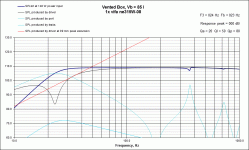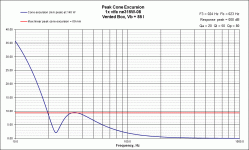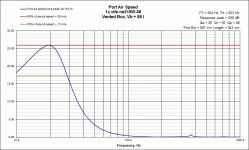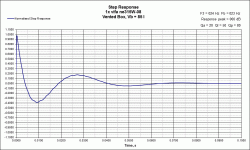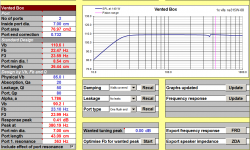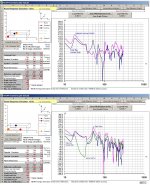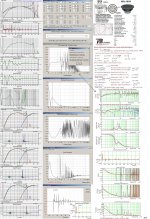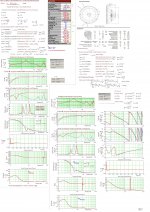It might be a bit above the price range but this Vifa NE315W-08 12" Subwoofer Speaker 264-1142 models very nicely in an 85L vented enclosure. edit: the slight wiggle in the step response is from the port resonance, but if you cross it over at say 80Hz it should have a minimal effect I would think.
You would want to high pass it at 20Hz. You mention 8.5Hz on some movie tracks, but are there any DVD players that will faithfully reproduce that low a frequency?
just some food for thought 🙂
Tony.
You would want to high pass it at 20Hz. You mention 8.5Hz on some movie tracks, but are there any DVD players that will faithfully reproduce that low a frequency?
just some food for thought 🙂
Tony.
Attachments
Last edited:
It might be a bit above the price range but this Vifa NE315W-08 12" Subwoofer Speaker 264-1142 models very nicely in an 85L vented enclosure. edit: the slight wiggle in the step response is from the port resonance, but if you cross it over at say 80Hz it should have a minimal effect I would think.
You would want to high pass it at 20Hz. You mention 8.5Hz on some movie tracks, but are there any DVD players that will faithfully reproduce that low a frequency?
just some food for thought 🙂
Tony.
Thanks, this is very interesting. I'll respond to the note about DVD or Bluray players first, as this is going to be another long one. I've asked Arcam about the frequency limits on the LFE output from the AVR 300. As the link from the Bluray player to the amp is digital (electrical coax) it will be the line output of the amp which will be of interest. Even if this does not have bandwidth down to 8.5 Hz, it may end up being complemented by another DAC at some point, and I'm going to build the sub to anticipate future hardware upgrades I might make.
I have looked up the Vifa NE315W-08 and modelled it both in a 90 litre vented enclosure and also in a sealed box of 50 litres, and compared it to the Scanspeak 30W/4558T00 which I liked from the previous models. Looking at the region below 20 Hz, it is apparent that the cone excursion is uncontrolled below the tuning frequency, so I added a 20 Hz 2nd order filter to stop this so that the comparisons of the peak power when the drivers reach maximum excursion can be meaningful.
An externally hosted image should be here but it was not working when we last tested it.
An externally hosted image should be here but it was not working when we last tested it.
An externally hosted image should be here but it was not working when we last tested it.
An externally hosted image should be here but it was not working when we last tested it.
Looking at the plots, it is clear that if we limit the cone excursion below the tuning frequency, the model predicts a hell of a lot of bass, and beats the closed boxes down to 15 Hz. I can see why turbodawg and KaffiMann recommended ported designs! Looking at the group delay, I can quite accept that this won't be a problem at less than 30 ms until very low. Whether this is what I need or not therefore just depends on whether I need to get up to 108 db, which I still have not worked out.
Thinking about whether I could improve the low frequency end I've also tried lowering the tuning frequency for the ported design to see if I could leave off the high pass filter at 20 Hz. While I was reading the material about Audibility of group delay that turbodawg kindly suggested I read, I did come across some discussion about designs with low Q sounding faster and I looked again at why I was using closed boxes with Qtc set to 0.707. This was originally to give a smooth response in the crossover region, and to keep the box volumes smaller. Anyway, if I am looking again at things, I'll try using Qtc 0.577, the value for the lowest group delay, and see how the overall response changes. So, I have modelled the Vifa NE315W-08 again but with the tuning set to 11 Hz, and the Scanspeak 30W/4558T00 in a 100 litre box, and compared them to the two drivers just in 50 litre boxes.
An externally hosted image should be here but it was not working when we last tested it.
An externally hosted image should be here but it was not working when we last tested it.
An externally hosted image should be here but it was not working when we last tested it.
An externally hosted image should be here but it was not working when we last tested it.
So, looking at the vented design tuned to 11 Hz, the vents need to be 212 cm long. This is possibly something I could get into, but not for my first build, I think! I have seen some subs with great big drainage tubes wrapped round the box, but if the tube gets as big as the sub, is it something else? I have not read up on horns and folded tubes and all sorts of esoteric stuff, so is that where this design concept ends up? Looking at the cone extension, even without any filter, it is controlled to 10 Hz, and the power us up to 120 W.
Looking at the Qtc 0.577 100 litre sealed design, there is a higher transfer function in the bass from 30 Hz down than the smaller box, but the power is now limited to 50 W, so overall SPL levels fall to 102 db at 50 Hz, and the maximum from 10 to 20 Hz is the same as for the 50 litre box. I suppose if you did not need this much volume you might find the lower bass was relatively louder simply because there is less power in the mid bass. Is this important for music or theatre use?
So, a final test. What happens if I include the crossover, and the effects of then adjusting the gain to match the other speakers? If I take the Scanspeak 30W/4558T00 and consider it is a 50 l sealed box, and in a 100 litre sealed box, apply a 5th order lowpass butterworth filter at 90 Hz, the equalise the gain to get the peak back to 0 db on the transfer graph, what happens?
An externally hosted image should be here but it was not working when we last tested it.
An externally hosted image should be here but it was not working when we last tested it.
An externally hosted image should be here but it was not working when we last tested it.
So, at the crossover the transfer function of the bigger box rolls off less steeply, but the power to reach maximum cone extension is lower for the bigger box so you get exactly the same maximum sund level out. Is the physical basis for this that at these low frequencies the driver gets no help from the box, there is no vent, and so at the same maximum cone extension, the same sound output is expected? Again, whether this setup is useful depends on whether I want the extra volume at above 20 Hz or if 102 db at 79 Hz is already louder than I need. Has anyone done measurements as to what they find to be the maximum SPL you might ever want at different frequencies? Next topic to research I think.
A final note is that after looking at the problems of matching phase between the main speakers and a sub, I'm thinking of just getting a plate amp with a phase control built in, but just out of interest what sort of filter is used to adjust the phase in these circuits?
Many thanks to all who have answered my questions here, I really do appreciate it.
Last edited:
Elliot Sound Products
Hi there DrN: Have you looked into Rod Elliot's web site: "Elliot Sound Products"? He has various articles regarding sub woofer's and a world of information. Look for projects 48 and 48a, wherein he introduces the subject, provides driver recommendations, box designs and necessary circuits. regards, Michael
To get the maximum from the T-Rex footfalls scene is exactly what I want from this in terms of extension and volume. If I can get that without sacrificing timing, then I'll be very happy.......?
Hi there DrN: Have you looked into Rod Elliot's web site: "Elliot Sound Products"? He has various articles regarding sub woofer's and a world of information. Look for projects 48 and 48a, wherein he introduces the subject, provides driver recommendations, box designs and necessary circuits. regards, Michael
Last edited:
Very large, long ducts can end up being similar to tapped horns or TQWP (tuned quarter wave pipe) response.I have seen some subs with great big drainage tubes wrapped round the box, but if the tube gets as big as the sub, is it something else? I have not read up on horns and folded tubes and all sorts of esoteric stuff, so is that where this design concept ends up?
Has anyone done measurements as to what they find to be the maximum SPL you might ever want at different frequencies?
A final note is that after looking at the problems of matching phase between the main speakers and a sub, I'm thinking of just getting a plate amp with a phase control built in, but just out of interest what sort of filter is used to adjust the phase in these circuits?
Tapped horns can give around 6 dB more output at the same excursion as a bass reflex cabinet, but require a bit more size. Sensitivities in excess of 100 dB at one watt one meter down in the 30 Hz range are possible, I just built a sub for outdoor patio use 58 x 31 x 12.5 inches using a pair of $5 10" speakers that does 99 dB half space with one watt and has solid response to 25 Hz outdoors against the house wall.
It was as easy to build as a bass reflex cabinet.
There has been much research and measurement to determine equal loudness contours, which show how much LF is needed to "keep up" with midrange, attached is an example I used for my comments in post # 5.
As you can see, at low SPL levels almost double the dB number is needed for VLF to sound the same as midrange, while at high SPL the ear's response flattens out. This makes it easier to mix at high volume, which is unfortunately why many concerts are way louder than needed🙄.
Personally, I find around 105 dB clean capability at 20 Hz to be plenty, as it allows movie speech at a normal level and LFE to keep up.
If you really are going for the immersion effect, (which I usually find uncomfortably loud in the midrange) that is gunfights and explosions at actual war SPL level, you may want around 125 dB at 20 Hz.
As far as phase controls in plate amps, there are many different types and slopes, the better amps are more likely to specify the slope and how the phase is altered, if it is a variable control rather than a simple polarity reverse.
Art Welter
Attachments
Last edited:
You mention 8.5Hz on some movie tracks, but are there any DVD players that will faithfully reproduce that low a frequency?
just some food for thought 🙂
Tony.
Hm, if it goes through hdmi it should. Maybe not through the minuscule op amp in the output stage of a cheap bd player :S
Hi DrDyna,
"...Maybe not through the minuscule op amp in the output stage..."
As long as the input impedance of the following amp doesn't put an undue load on the output stage opamp (in which case not only the low end would be affected), the opamp does not have any real low frequency limitations.
Regards,
"...Maybe not through the minuscule op amp in the output stage..."
As long as the input impedance of the following amp doesn't put an undue load on the output stage opamp (in which case not only the low end would be affected), the opamp does not have any real low frequency limitations.
Regards,
if you are connecting digitally then I guess it's no longer relevant to the DVD player, and becomes a question for the decoder... I guess one day I'll get out of the stoneage and move away from simple old stereo for watching movies 😉 I was thinking about typical analogue outputs from DVD players 🙄
Tony.
Tony.
A different idea to what's already gone - what about some tapped horns?
I built a pair of the Exodus Anarchy THs, and used the TB 6.5" subwoofer.
LittleMike's Anarchy Tapped Horn - Home Theater Forum and Systems - HomeTheaterShack.com
Reed Exodus Anarchy 25hz Tapped Horn
You don't have to understand how it'll work, just note that you'll still need an infrasonic filter.
The guy that built them (2nd link) reports >120dB from a quad of them (that's right - 4x6.5" drivers). Two of them will, I suspect, suffice. They certainly did for me. They're 70L each, but very slim (just over 7" wide) - you could fit one behind the sofa.
Some other THs here - note you can make them very tall and slim, then sit them in a corner, or along a wall.
Beware - herein lieth madness.
Chris
I built a pair of the Exodus Anarchy THs, and used the TB 6.5" subwoofer.
LittleMike's Anarchy Tapped Horn - Home Theater Forum and Systems - HomeTheaterShack.com
Reed Exodus Anarchy 25hz Tapped Horn
You don't have to understand how it'll work, just note that you'll still need an infrasonic filter.
The guy that built them (2nd link) reports >120dB from a quad of them (that's right - 4x6.5" drivers). Two of them will, I suspect, suffice. They certainly did for me. They're 70L each, but very slim (just over 7" wide) - you could fit one behind the sofa.
Some other THs here - note you can make them very tall and slim, then sit them in a corner, or along a wall.
Beware - herein lieth madness.
Chris
I just want it noted that I did not specifically recommend a ported solution, I merely advise you to look at alternative solutions. I do prefer most other options than ported and closed, but that is just personal preference, almost any design can sound good and give you deep bass. But your 100L size limit will restrict low end performance, or spl capability.
How deep do you really need to go? I'd say anything below 20-25hz is unrealistic unless you can eq and force feed insane amounts of power into it, which is wasteful in my opinion, high power costs money if you want it to be clean.
Horns are nice, TH/TP decent enough if you want low end, does not have to be huge, chris661's suggestion is valid, there is something very fun about th's with small drivers, it is surprisingly good compared to size and cost.
I do not think closed boxes are easier to build than other designs is all I'm saying.
Pick your poison. If there is such a thing as an ultimate subwoofer, it's huge.
Not sure if it is the worlds largest, but probably the worlds largest MOBILE subwoofer:
The Matterhorn - Worlds Largest Subwoofer - YouTube
How deep do you really need to go? I'd say anything below 20-25hz is unrealistic unless you can eq and force feed insane amounts of power into it, which is wasteful in my opinion, high power costs money if you want it to be clean.
Horns are nice, TH/TP decent enough if you want low end, does not have to be huge, chris661's suggestion is valid, there is something very fun about th's with small drivers, it is surprisingly good compared to size and cost.
I do not think closed boxes are easier to build than other designs is all I'm saying.
Pick your poison. If there is such a thing as an ultimate subwoofer, it's huge.
Not sure if it is the worlds largest, but probably the worlds largest MOBILE subwoofer:
The Matterhorn - Worlds Largest Subwoofer - YouTube
Last edited:
Hi there DrN: Have you looked into Rod Elliot's web site: "Elliot Sound Products"? He has various articles regarding sub woofer's and a world of information. Look for projects 48 and 48a, wherein he introduces the subject, provides driver recommendations, box designs and necessary circuits. regards, Michael
Thanks, that looks like a great site. I have read the article 'The subwoofer conundrum'.
Very large, long ducts can end up being similar to tapped horns or TQWP (tuned quarter wave pipe) response.
Tapped horns can give around 6 dB more output at the same excursion as a bass reflex cabinet, but require a bit more size. Sensitivities in excess of 100 dB at one watt one meter down in the 30 Hz range are possible, I just built a sub for outdoor patio use 58 x 31 x 12.5 inches using a pair of $5 10" speakers that does 99 dB half space with one watt and has solid response to 25 Hz outdoors against the house wall.
It was as easy to build as a bass reflex cabinet.
There has been much research and measurement to determine equal loudness contours, which show how much LF is needed to "keep up" with midrange, attached is an example I used for my comments in post # 5.
As you can see, at low SPL levels almost double the dB number is needed for VLF to sound the same as midrange, while at high SPL the ear's response flattens out. This makes it easier to mix at high volume, which is unfortunately why many concerts are way louder than needed🙄.
Personally, I find around 105 dB clean capability at 20 Hz to be plenty, as it allows movie speech at a normal level and LFE to keep up.
If you really are going for the immersion effect, (which I usually find uncomfortably loud in the midrange) that is gunfights and explosions at actual war SPL level, you may want around 125 dB at 20 Hz.
As far as phase controls in plate amps, there are many different types and slopes, the better amps are more likely to specify the slope and how the phase is altered, if it is a variable control rather than a simple polarity reverse.
Art Welter
Right, based on the fact that my amp actually displays the power output from 0 to 100 db, where 100 db is 120W per channel, and the speakers have sensitivity of 88 db per Watt, I have done an entirely uncalibrated calibration of how loud I have my system when listening to music. I found that with a selection of the 'loudest' albums in my CD collection, Radiohead's OK computer and the Foo Fighters' Wasting Light (which I assume are the ones which have transients which are closest to clipping over the 2V rms standard) the volume level I found to be 'normal' was 66, and the loudest I could tolerate for longer than 5 seconds was 70. I have 77 set as the hard limit in the setup menu to stop the kids trashing the speakers. These levels correspond to 0.0465 W per speaker or 78 db at 1m (doubling the volume as there are two speakers so adding 3 db), 0.117 W or 82 db at 1m , and 0.6 W per speaker or 89 db at 1m.
Did I spend out on 120W per channel to rock out at 1.2W total power? I can deal with log stuff fine if it's something I measure with an instrument but when it also corresponds to something I can feel it just seems weird. Anyway, looking at the speakers, the 6.5" woofers are going at about +/- 1 mm which does indeed seem to work out to 1 W when I model a 6.5" unit in a 10 litre box in WinISD.
So lets say I would like to listen at an average level of usually 78 db at 1 kHz, occasionally 82 db and probably never more than 89 db. Does this sound (no pun intended) plausible? If all I need is the ability to reproduce everything up to 90 db, then I can get this with a 50 litre box and a 12" driver for everything over 15 Hz if I use equalisation to flatten the response out.
Looking at the equivalent volume curves provided very kindly by Art, to get equal subjective loudness across from 1 kHz to 30 Hz this would mean I need between 110 and 120 db at the low end. Not happending in my house, I think, I have had a lot of plastering done and I want it staying stuck on the walls and ceilings. However, for accurate reproduction of a soundtrack say, isn't it sufficient to get a flat reproduction over as wide range as possible, and accept that the bass end will sound lower in volume, because that is how it would sound if you heard it for real?
I'm coming to see that I will not get anything going on in one box that will take over from the main speakers at 90-130 Hz and go down to 10 Hz in any enclosure compatible with family life here, it was a dream I had but it's not going to happen.
I just want it noted that I did not specifically recommend a ported solution, I merely advise you to look at alternative solutions.
Absolutely, everyone on this board has been most helpful in suggesting different things I should read and consider, which was exactly what I came here for.
I do prefer most other options than ported and closed, but that is just personal preference, almost any design can sound good and give you deep bass. But your 100L size limit will restrict low end performance, or spl capability.
How deep do you really need to go? I'd say anything below 20-25hz is unrealistic unless you can eq and force feed insane amounts of power into it, which is wasteful in my opinion, high power costs money if you want it to be clean.
Horns are nice, TH/TP decent enough if you want low end, does not have to be huge, chris661's suggestion is valid, there is something very fun about th's with small drivers, it is surprisingly good compared to size and cost.
I do not think closed boxes are easier to build than other designs is all I'm saying.
Pick your poison. If there is such a thing as an ultimate subwoofer, it's huge.
Not sure if it is the worlds largest, but probably the worlds largest MOBILE subwoofer:
The Matterhorn - Worlds Largest Subwoofer - YouTube
I read about the Tapped Horns with great interest. I really love the idea, they seem even more in the DIY spirit than just putting a big driver in a box. My immediate priority is to build something acceptable to everyone that will cross over cleanly from the main speakers, and go down as far is is practicable in a 100 litre package. To keep the crossover region clean and avoid timing problems, this will sit right next to one of the speakers. However, there is no reason I couldn't come back in the future to look again at the subcontrabass octave and below in future, if there was a way to hide a big but thin speaker behind a chest of drawers or a floor to ceiling bookcase for example. I love this idea. It will be too much to try to do all at once, I'll have to get a more conventional sub built and let everyone get used to it, then wait until the time is right! Thanks so much Chris and KaffiMann for pointing these out to me.
So, I've looked again at what might be achievable, and what I need, and I'm still not sure that the figure of 90 db that I've com up with for volume is definite, but if it is, I can get down to 15 Hz with a 50 litre box and a 12" driver for 100 W, or if I assume I need an extra 10 db at the bottom end, 28 Hz. If I go with a vented 80 litre box, with an 20 Hz tuning for the vent, and a stiff cutoff at 16 Hz to protect the driver I could get 188W power in, and get 90 db at 14 Hz or 100 db at 18Hz.
An externally hosted image should be here but it was not working when we last tested it.
I looked again at the issue of what plate amp to go for and I found people talking about the Hypex plate amps with DSP built in. I like the idea of being able to filter in the sub, as then it is less key for me to worry about trying to keep the reponse completely flat. I also like that it has a digital input, but I think it will only be useful for stereo signals, and won't take a full 5.1 feed, which is what the Bluray and amp will have available.
If I were to go for this I could then get the highpass filter as low as possible for the design (although there might be another filter on the analog LFE channel in HT use), and would be free to equalise the low end above that up if needed, within the envelope of the overall spl curve.
Oh well, more to think about.
Last edited:
Hi All,Late 
Post#1:
I plugged in your room into this program and found You need more than one sub to get even FR in the room modal region: See the picture:...and...:
Room Response Calculator - Reflective Accumulation Simulation Software
Post#9
The Tangband WQ-1858 is IMO a very good driver and suitable for a main sub that can be integrated with the Mains without the need of EQ's or signal delay units:See the picture
Post#21:
IMO: The Vifa NE315-08 needs to be reworked:See the picture:
b 🙂

Post#1:
...my room being 3.2m wide, 2.4m high and 10m long. The lowest modes should be (according to Room Mode / Standing Wave Calculator) 17.2, 34.4, and 51.6 and so on down the length, and then multiples of 54 across and 72 vertically...
I plugged in your room into this program and found You need more than one sub to get even FR in the room modal region: See the picture:...and...:
Room Response Calculator - Reflective Accumulation Simulation Software
...The Tangband WQ-1858 appears to have a very flat response down into the low end in the recommended cabinet size, which might be a useful thing as I don't know where the crossover will be until I've built it. The measured response at Europe Audio WQ-1858.pdf also looks quite flat in this region from 20 to 100 Hz...
Post#9
...To get the maximum from the T-Rex footfalls scene is exactly what I want from this in terms of extension and volume. If I can get that without sacrificing timing, then I'll be very happy...
The Tangband WQ-1858 is IMO a very good driver and suitable for a main sub that can be integrated with the Mains without the need of EQ's or signal delay units:See the picture
Post#21:
..It might be a bit above the price range but this Vifa NE315W-08 12" Subwoofer Speaker 264-1142 models very nicely in an 85L vented enclosure. edit: the slight wiggle in the step response is from the port resonance, but if you cross it over at say 80Hz it should have a minimal effect I would think...
IMO: The Vifa NE315-08 needs to be reworked:See the picture:
b 🙂
Attachments
Hi All,Late
Post#1:
I plugged in your room into this program and found You need more than one sub to get even FR in the room modal region: See the picture:...and...:
Room Response Calculator - Reflective Accumulation Simulation Software
Thanks for looking at this. I am going to have to work out where to put it with some care, I can see.
As for having two, there's the laws of physics which I try to obey, and then there's She Who Must Be Obeyed. She wins, so I'm going to have one sub, and just try to find the best place place for it!
The Tangband WQ-1858 is IMO a very good driver and suitable for a main sub that can be integrated with the Mains without the need of EQ's or signal delay units:See the picture
It does look good. I've been following up on the suggestion from Arty that I should look at a sealed cabinet but use a Linkwitz transform to flatten the bass response down to the required level, and have modelled this driver below using this sort of EQ. It looks very promising.
So, to recap, I looked first at simple sealed designs, not relying on equalisation, but there is no way I could build one big enough to deliver the required low end extension, which I'm still hoping to get to 20 Hz flat, and then if there was anything detectable below that would be nice. I then looked at vented designs, but the length of vents needed would be over 2 m, so again this would not work for me.
Having eliminated these options I have looked at going back to a sealed box, but using equalisation to get the required response. One of the reasons I was resistant to this at first, was that I have not had a sub before and have little idea of how it would fit into my room, and what sort of equalisation might be needed to stop it booming at some frequencies. Anyway, after looking at the possibilities for amplification, I've been drawn to the idea of using a miniDSP to implement a Linkwitz transform. This seems to be common practise, so I'm hopeful it will be what I need.
The drivers I'm considering are:
Dayton RSS390HF-4, 15", £203 (I'm in the UK, please don't tell me how much more I'm going to pay than elsewhere).
Tangband WQ-1858 12", £167.
Peerless 835017 XXLS 12", £195
I was also looking at the Eminence Lab 15 driver, availble for £185 but it does not appear any better than the 12" drivers, and less flat in a small box.
Looking at the models, I've used a 2nd order high pass filter set at 5 Hz to limit the cone extension to xmax, then set the box size to 80 litres, and added the Linkwitz trasform to make fp 20 Hz and Qp 0.707. I then set the signal level to get the cone excursion to equal xmax. I've included the Tangband with and without the Linkwitz transform.
An externally hosted image should be here but it was not working when we last tested it.
An externally hosted image should be here but it was not working when we last tested it.
An externally hosted image should be here but it was not working when we last tested it.
It is clear that with the equalisation, the maximum power that can be used is limited by the cone excursion at the lower frequencies, so from the model it seems that you could only use quite low power levels with equalised speakers like this. Is this correct, or is this an artefact of how the WinISD program works? Looking at the amplifier load the power levels seem higher.
An externally hosted image should be here but it was not working when we last tested it.
I need to sort this out to know what amp power I'll need. I'm hoping 200 W should be fine for the 12" drivers, which is where I'm leaning at present, as I don't think I want so much volume, as long as it will go low.
Just for a laugh I've also looked at how the Peavy Low Rider 18" came up (same as the Dayton 15" if you want to transform it to f0 = 20 Hz) and the Aura NS18-992-4A (18" £600 and will give 103 db at 20 Hz) the B&C 18SW115 which costs and performs the same, and the B&C 21SW150, which is capable of 106 db at 20 Hz, and costs £770. Oh well, if I win the lottery.
I've ordered a Dayton RSS390HF-4, so the plan is
Dayton RSS390HF-4
MiniDSP (with analogue volume pot to go on the back)
BKElectrics Mosfet Module (still working out what power)
I've been working on the basis of an 80 litre box, and modelling this that gives Qtc of 0.875, so not out of the park to correct by equalisation. The box dimensions could be 40 x 55 x 40 cm internal with 8 litres over for the driver and amp volume, and I'm planning to make it from 25 mm plywood, with some braces. Next thing to figure out is how to mount the amp and how get a good smooth paint finish on the casing.
Just wondering what the best way to power the MiniDSP will be, can I run some lines from an appropriate point on the BK amp?
Dayton RSS390HF-4
MiniDSP (with analogue volume pot to go on the back)
BKElectrics Mosfet Module (still working out what power)
I've been working on the basis of an 80 litre box, and modelling this that gives Qtc of 0.875, so not out of the park to correct by equalisation. The box dimensions could be 40 x 55 x 40 cm internal with 8 litres over for the driver and amp volume, and I'm planning to make it from 25 mm plywood, with some braces. Next thing to figure out is how to mount the amp and how get a good smooth paint finish on the casing.
Just wondering what the best way to power the MiniDSP will be, can I run some lines from an appropriate point on the BK amp?
Right, I used the spreadsheet kindly made avaible by Trueaudio, which I found here, to calculate the boost that the Linkwitz transform I was using was applying. Thanks to the guys who wrote this page, for the guidance. It turns out to be 11.67db, so this multiplies the input power by 2^(11.67/3) = 14.8, so the 30 W signal I was modelling is actually effectively 447 W. The model shows a peak of just over 320 VA for apparent amplifier load, so is the difference due to the phase behavious of the system? Anyway, if I need 450 W to drive this to hit the limits, I'm quite happy to drive it with a less powerful amp and not go overboard. The BK amp I was thinking of gives 215 W into 4 Ohms, or to model it, 14.5 W if you divide by the boost factor. This gives 86 db at 10 Hz and 95.5 db at 20 Hz from the WinISD model including the Linkwitz transform. From my very inexact calculations, I needed 78 db to match my regular listening, and up to 82 db for what I'd regard as loud, so this should do okay.
So, that will be the amp, I have ordered the driver, and now I have to get the other bits (mains plug, on off switch), and build the box.
So, that will be the amp, I have ordered the driver, and now I have to get the other bits (mains plug, on off switch), and build the box.
As for the question how loud will 20Hz be at 86db I can't really answer except to say, you won't be able to hear 20Hz, you can feel it (if it has enough power) but not hear it.
Tony.
I disagree on not hearing it but due to the hearing sensitivity at the extremes it will have to be pretty loud. As 'proof' I submit that pipe organ builders sometimes use 32 ft stops that go down to 16/17 Hz. If it couldn't be heard (merely felt) would it need to be tuned? You can definitely tell if the wrong note is played. BTW it's a wonderful sound way down at the bottom.
Human Hearing: Amplitude Sensitivity Part 1 — Reviews and News from Audioholics
G²
I did a bit of a google search, right here in my own city is a pipe organ that goes down to 8.18 Hz!! Frequencies I will have to keep an eye out for a recital!!
Tony.
Tony.
I did a bit of a google search, right here in my own city is a pipe organ that goes down to 8.18 Hz!! Frequencies I will have to keep an eye out for a recital!!
Tony.
You won't even have to buy a ticket, just arrange to be within a block or two...
Right, I used the spreadsheet kindly made avaible by Trueaudio, which I found here, to calculate the boost that the Linkwitz transform I was using was applying. Thanks to the guys who wrote this page, for the guidance. It turns out to be 11.67db, so this multiplies the input power by 2^(11.67/3) = 14.8, so the 30 W signal I was modelling is actually effectively 447 W. The model shows a peak of just over 320 VA for apparent amplifier load, so is the difference due to the phase behavious of the system? Anyway, if I need 450 W to drive this to hit the limits, I'm quite happy to drive it with a less powerful amp and not go overboard. The BK amp I was thinking of gives 215 W into 4 Ohms, or to model it, 14.5 W if you divide by the boost factor. This gives 86 db at 10 Hz and 95.5 db at 20 Hz from the WinISD model including the Linkwitz transform. From my very inexact calculations, I needed 78 db to match my regular listening, and up to 82 db for what I'd regard as loud, so this should do okay.
So, that will be the amp, I have ordered the driver, and now I have to get the other bits (mains plug, on off switch), and build the box.
Hi. You don't mention what frequency you are trying to equalize this box to? The lower you want it to go flat, the more gain you're going to need to have, obviously perhaps. I ran some simulations in HornResp, with the Dayton in an 80l closed box, and it shows that the driver takes 35Volts (around 300W into 8Ohm) to reach Xmax at 30Hz and below. This gives an SPL of 109dB at 30Hz (at 1 meter distance).
It would seem reasonable to me to equalize this box flat to only 30Hz, and let the natural rolloff below 30Hz remain. So try to use 30Hz as the new -3dB point, and this will leave you with a respectable 102dB at the -10dB point of 20Hz. In my opinion if you try to equalize flat to 20Hz, you're using up the xmax so soon that you don't get enough level throughout the rest of the band.
Additionally, due to the very long wavelengths at these low frequencies (5.7m half-wave at 30Hz), you're very likely to get room gain below your chosen cutoff, counteracting the falling response somewhat. Also, for 30Hz, you won't need insane amounts of gain, once you're getting into double digit decibles (10dB = x10 power), you risk amplifying noise as well.
Many people recommend using half again the amp capacity of the maximum power you want to use, so for a box that hits xmax at 300watt/4Ω, you'll ned an amp capable of 450W/4Ω. As for your Minidsp, any 12V source of power will do, in my subwoofer amp, I have my Minidsp connected to the outputs of the amp's power supply (which is a 35V DC supply) using a 7812 linear voltage regulator with some smoothing caps, works just fine.
Hi. You don't mention what frequency you are trying to equalize this box to? The lower you want it to go flat, the more gain you're going to need to have, obviously perhaps. I ran some simulations in HornResp, with the Dayton in an 80l closed box, and it shows that the driver takes 35Volts (around 300W into 8Ohm) to reach Xmax at 30Hz and below. This gives an SPL of 109dB at 30Hz (at 1 meter distance).
I was going for 20 Hz as the -3 db point. My reasoning was that at lower volume levels, I'll perceive the lower frequencies as less loud relative to the midband, so if they are boosted more, then that would suit my somewhat quieter listing habits.
It would seem reasonable to me to equalize this box flat to only 30Hz, and let the natural rolloff below 30Hz remain. So try to use 30Hz as the new -3dB point, and this will leave you with a respectable 102dB at the -10dB point of 20Hz. In my opinion if you try to equalize flat to 20Hz, you're using up the xmax so soon that you don't get enough level throughout the rest of the band.
Additionally, due to the very long wavelengths at these low frequencies (5.7m half-wave at 30Hz), you're very likely to get room gain below your chosen cutoff, counteracting the falling response somewhat. Also, for 30Hz, you won't need insane amounts of gain, once you're getting into double digit decibles (10dB = x10 power), you risk amplifying noise as well.
Thanks, I do take your point about too much gain amplifying noise up. I might start with no equalisation and then try just flattening out the curve, then setting different f3 values going down and just play about. This is one of the things that attracted me to the idea of using the miniDSP.
Many people recommend using half again the amp capacity of the maximum power you want to use, so for a box that hits xmax at 300watt/4Ω, you'll ned an amp capable of 450W/4Ω. As for your Minidsp, any 12V source of power will do, in my subwoofer amp, I have my Minidsp connected to the outputs of the amp's power supply (which is a 35V DC supply) using a 7812 linear voltage regulator with some smoothing caps, works just fine.
Thanks, I might have to go for the MF450 then! I was wondering if speccing it too small would have a negative impact on transients or on the overall quality of the sound. Thanks for the note on the regulator, I was hoping it would be that simple.
I've been working on the basis of an 80 litre box, and modelling this that gives Qtc of 0.875, so not out of the park to correct by equalisation.
I am not so sure this is a good idea. I have read that the HF subs are prone to "oil-can", or pinging when used in a smaller box:
Dayton Titanic vs. Reference HF vs. HO Subs
Low end EQ in a sealed box puts lots of stress on the driver, you may have a problem here. I would suggest either:
-increasing box size, use plenty of fiberglass internally, then EQ.
-increasing box size and porting
-use a HO series woofer instaid, with the thicker cone.
......or you might be just fine.
- Status
- Not open for further replies.
- Home
- Loudspeakers
- Subwoofers
- Trying to design the world's simplest sub
